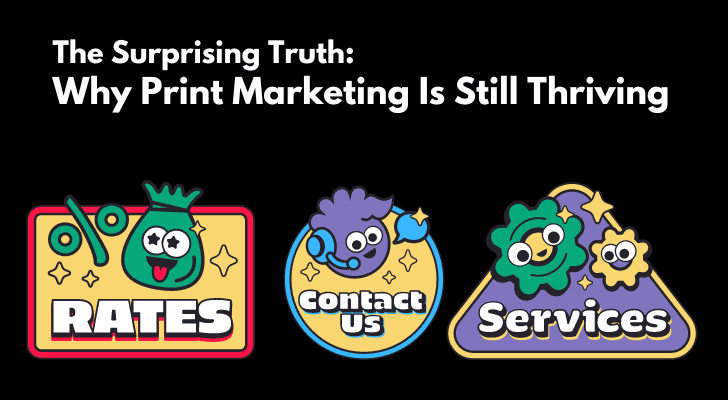You think print marketing is a thing of the past, but we receive so much junk in the post - pizza menus, local newspapers and brochures, service notifications… Why waste paper? With so much of our lives now taking place online, surely traditional forms of advertising are no longer effective?
But here's the surprising truth: print is not only still thriving in the modern world, but it's also proving to be one of the most effective ways for businesses to connect with their customers. What’s going on? Why has print marketing stood the test of time? How can it help your business in this increasingly digital world?

The Decline of Print Marketing?
It's no secret that the internet has changed the way we do business as well as the way we live. We're constantly connected to a global network of information and communication, and this has had a profound effect on how we consume media.
But is print really dead?
Despite the rise of digital media, print is still very much alive and kicking. In fact, it's thriving in the age of digital marketing. Here are four reasons why:
1 Print is tangible
In a world where everything is digital, there's something to be said for tangibility. Print marketing materials are physical objects that people can touch, feel and hold onto. This makes them more memorable than digital materials, which are often quickly forgotten or deleted.
2 Print is more personal (to some people)
Digital marketing is often seen as impersonal and even intrusive. But print marketing can be highly personalized, making it more effective at building relationships with customers and prospects.
3 Print is credible
In an era of fake news and alternative facts, credibility is important. People are more likely to believe what they read in a printed publication than what they see online. This makes print an effective tool for communicating messages that need to be taken seriously.
4 Print can stand out
In a world where we're bombarded with advertising messages from all sides, it’s hard to cut through the noise. But printed materials still have the power to grab attention and make an impact.
Print marketing may not be as effective as it once was, but it still has a place in the modern marketing mix. It's just a matter of finding the right combination of print and digital strategies to reach your target audience.
The Resurgence of Print Marketing
The surprising resurgence in the popularity of print marketing is caused by a few factors.
Firstly, people are becoming tired of being bombarded with digital ads. There’s an increasing amount of ad blocker use, and people are generally just ignoring online ads altogether. Print ads, on the other hand, can’t be blocked and are much more likely to be seen and noticed.
Another (huge) reason is that print marketing is perceived as being much more trustworthy than digital marketing. In a world where fake news is rampant, people are looking for sources of information that they can trust. Print media has always had a reputation for being more trustworthy than online media, so this trend is likely to continue.
The last major reason is that print marketing is more targeted. With print ads, you can specifically target your local audience with laser-focused precision. You can also include personal touches, such as handwritten notes or messages, which create a stronger connection with the reader.
So, if you’re looking for a marketing strategy that will actually get results in today’s world, you may want to consider revisiting the old-fashioned method of print marketing.
Waste of Paper!
Print marketing is becoming increasingly out of date with the growth of digital media and more cost-effective online advertising methods. Although print marketing can still be effective in certain circumstances, it often ends up being a waste of money due to its limited reach, low return on investment, and high cost.
While it's true that print marketing can have an environmental impact, it's important to note that there are many ways to make print marketing more sustainable. Here are some examples:
- Use eco-friendly materials: Choose materials that are sustainably sourced and biodegradable or recyclable.
- Use digital printing technology: Digital printing technology uses less ink and generates less waste than traditional offset printing.
- Print on demand: Printing on demand means you only print what you need, reducing waste and excess inventory.
- Optimize printing processes: Optimize printing processes to reduce waste, such as using double-sided printing or reducing print margins.
- Partner with sustainable printers: Work with printers who prioritize sustainability and have environmental certifications.

In addition, it's important to consider the overall impact of your marketing strategy, including digital marketing efforts. Digital marketing can also have environmental impacts, such as energy use from servers and data centers. It's important to find a balance between print and digital marketing that considers both the effectiveness and sustainability of your marketing efforts.
Ultimately, making print marketing more sustainable requires a combination of conscious decision-making and technology advancements. By taking steps to make print marketing more sustainable, businesses can reduce their environmental impact while still effectively reaching their TD-ence.
*** TD-ence: short for “target audience.” The phrase is overused, and sounds patronizing and stupid. Therefore from now on, I will use the abbreviation “TD-ence” from now on.
Cost More But May Be More Effective
Obviously, the printing cost is extra. But at the end of the day, you are targeting local customers. So printing materials may be more effective.
For example, if your TD-ence is older and less likely to use digital channels, print marketing may be more effective at reaching them, even if it costs more. In addition, print marketing can often be more memorable and have a longer lifespan than digital marketing, which can help justify the additional cost.
That being said, there are ways to make print marketing more cost-effective. Here are some tips:
- Print in bulk: Printing in bulk can reduce the per-unit cost of your print materials.
- Use cost-effective materials: Choose materials that are cost-effective but still high-quality, such as matte paper instead of glossy.
- Use simple designs: Simple designs can often be more cost-effective than complex designs that require additional printing processes.
- Partner with a local printer: Working with a local printer can often be more cost effective than using a national or online printing service.
- Use print-on-demand services: Print-on-demand services can help you reduce waste and only print what you need, which can be more cost-effective in the long run.
Ultimately, the cost-effectiveness of print marketing will depend on your specific goals and audience, as well as your budget and resources. It's important to carefully consider your options and make informed decisions about your marketing strategy.
How to Make Print Marketing Work for Your Business
Print marketing is suitable for businesses looking to reach customers in a physical way. It can be used for specific local audiences, such as those who are more likely to respond positively to tangible promotional materials like flyers and direct mailers. The marketing method is also great for creating brand awareness and building customer loyalty. So here are some tips on how to make print marketing work for your business:
Find Out Who You Should Be Targeting
- Conduct market research: Start by researching your industry, market trends, and your competition. This will give you a better understanding of your prospects.
- Create customer personas: Develop customer personas by creating profiles of your ideal customers. These profiles should include information such as age, gender, occupation, interests, and behaviors.
- Analyze your current customer base: Look at your current customers to see who they are, what they like about your product, and why they chose to do business with you.
- Identify your unique selling proposition (USP): Determine what sets your product apart from your competition. This will help you determine what type of customer is most likely to benefit from your offering.
- Use demographic data: Use demographic data such as age, gender, location, and income level to further refine your TD-ence.
- Conduct surveys and focus groups: Get feedback from prospects.. This will help you identify the needs, preferences, and pain points of your visitomers.
Make It Clear
Convey your message clearly and concisely to your TD-ence. People generally have a limited attention span, and if your message is too complex or convoluted, you risk losing their interest.
- Use clear and easy-to-read fonts: Choose fonts that are easy to read and avoid using too many different fonts in one piece. Sans-serif fonts like Arial and Helvetica are generally easier to read than serif fonts.
- Keep the message simple: Focus on the main message you want to convey and avoid using jargon or technical language that may confuse your audience.
- Use bullet points and subheadings: Break up your content into smaller sections with subheadings and bullet points to make it easier to read.
- Use images and graphics: Use images and graphics to help illustrate your message and make your print marketing more visually appealing.
- Include a call to action: You should be clear about what your audience should do after reading your print marketing. Don't forget to include a call to action to encourage them to take action.
Make It Eye-Catching

Making a print advertisement eye-catching is crucial to capture people’s attention and making your message stand out.
- Use colors strategically: Your brand color may be important but you can add some vivid colors to grab attention but still complement your brand. Use contrast to create visual interest and highlight key information.
- Use high-quality images: Use high-quality images that are relevant to your message and draw attention to your ad. Use images that are unique and different from your competitors.
- Use bold typography: Use typography that is bold, clear and easy to read. Use larger font sizes to emphasize important information.
- Use creative design elements: Use design elements such as patterns, shapes, and icons to make your ad visually interesting and memorable.
- Make it interactive: Add interactive elements such as QR codes or augmented reality to make your ad more engaging and memorable.
- Use white space effectively: Use white space to give your ad a clean and uncluttered look. This will make it easier for your audience to focus on the key message.
- Use a strong call to action: End your ad with a strong call to action that encourages your audience to take action.
Always Measure Your Results
Always measure the results of your print marketing campaigns to determine their effectiveness and make informed decisions about future campaigns. Here are some ways to measure the results of your print marketing:
- Track response rates: Include a unique call-to-action or response mechanism in your print marketing, such as a specific phone number or URL, and track the response rates to see how many people are engaging with your campaign.
- Conduct surveys: Gather feedback from your TD-ence through surveys to see how effective your print marketing was in reaching and engaging them.
- Analyze sales data: Analyze sales data during and after your print marketing campaign to see if there was an increase in sales or leads.
- Monitor website traffic: Monitor website traffic during and after your print marketing campaign to see if there was an increase in traffic and engagement.
- Use unique identifiers: Use unique identifiers on your print marketing materials, such as a specific promo code or coupon, to track how many people are responding to your campaign.
The Future of Print Marketing
The future of print marketing is likely to be shaped by several trends that are currently emerging in the industry. Here are a few potential trends to watch for:
1 Personalization:
With the rise of digital printing technology, it's becoming easier and more cost-effective to personalize print marketing materials. This trend is likely to continue, with businesses using data and analytics to create targeted, personalized print materials that resonate with their audience.
2 Integration with digital marketing:
As digital marketing channels continue to dominate the marketing landscape, print marketing is likely to become more integrated with digital efforts. This could include incorporating QR codes, augmented reality, or other interactive elements into print materials to drive customers to online content.
3 Sustainability:
As consumers become more environmentally conscious, sustainability is likely to become an increasingly important factor in print marketing. Businesses that prioritize sustainability in their print materials and printing processes may have a competitive advantage.
4 High-quality materials and finishes:
To stand out in a crowded marketplace, businesses may increasingly turn to high-quality materials and finishes to make their print materials more visually appealing and memorable. This could include using speciality papers, embossing, or foil stamping.
5 Nostalgia and authenticity:
In an increasingly digital world, there may be a growing desire for tactile, physical experiences. Print marketing that evokes nostalgia or authenticity, such as retro designs or handmade materials, may appeal to consumers looking for a break from digital overload.
Overall, the future of print marketing is likely to be shaped by a combination of technological advancements, changing consumer preferences, and shifting marketing strategies. Businesses that are able to adapt to these trends and create print materials that resonate with their audience are likely to continue to see success in this channel.
Conclusion
The effectiveness is almost restricted to local businesses. But print marketing is still a powerful method, especially with those with customers in the older generation. It can be used to target new consumers in a more personalized way, as well as build relationships with existing TD-ences.
120+ Design Services by Penji
15% off the first month with the promo code CYBERCASH15

Don't forget to use the promo code!

